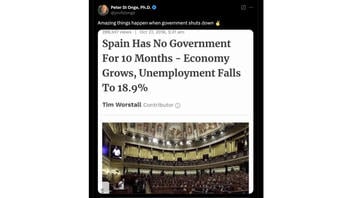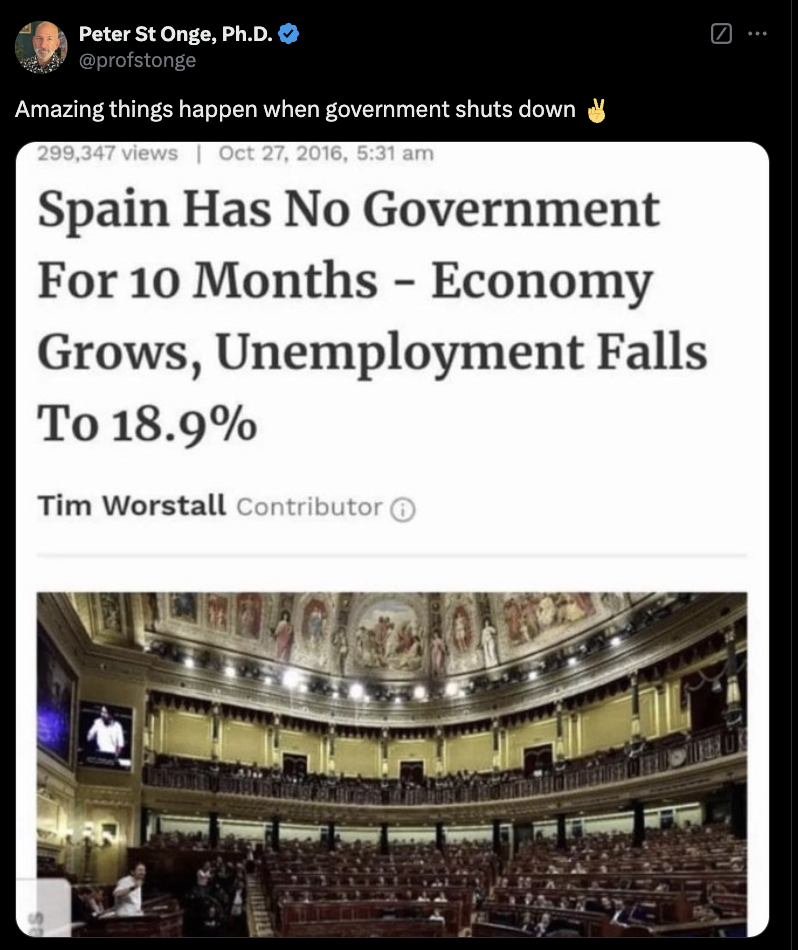STORY UPDATED: check for updates below.

Was the 2016 months-long Spanish political crisis the same as a government shutdown in the U.S.? No, that's not true: Spain, unable to form a new government at the time, did not experience a gap in national funding, and most government services were delivered as usual. In the U.S., shutdowns are triggered by the absence of an adopted permanent or temporary budget, which leads to reductions and delays in government services.
The claim appeared in a post (archived here) published on X on December 19, 2024. A caption that accompanied the post read, "Amazing things happen when government shuts down✌️." What appeared to be a screenshot of an article was also included in the post, which read:
Spain Has No Government
For 10 Months -- Economy
Grows, Unemployment Falls
To 18.9%.
This is what the post looked like on X at the time of writing:
(Source: X screenshot taken on Fri Dec 20 16:20:09 2024 UTC)
The post was shared as U.S. Congress neared the December 20, 2024, deadline (archived here) for a new federal spending bill approval after the previous bill had been taken off the plate. Later, this shutdown was averted (archived here).
The post reviewed in this fact check implied that there is no difference between a U.S. government shutdown and the political crisis Spain experienced between December 2015 (archived here) and October 2016 (archived here) as a result of the inability to form a new government due to two inconclusive elections (archived here). The two very distinctive scenarios between Spain and the U.S. occurred in different political systems under various circumstances.
Differences between Spain and the U.S.
Spain is a parliamentary constitutional monarchy (archived here), and therefore, the monarch is the head of the state (archived here). When a political party leader secures a sufficient majority during a general election, that person becomes the president of the government (archived here) and then moves on to form the cabinet.
In the U.S., the head of the state (archived here) is the president. That person nominates members of the cabinet (archived here) whose job is to advise the president. Members of the cabinet go through the confirmation process (archived here) in the Senate in accordance with the U.S. Constitution (archived here).
Shutdowns don't affect the composition of the cabinet, the U.S. House of Representatives (archived here), or the U.S. Senate (archived here).
The government shutdown in the United States is not at all the same as the existence of a caretaker government in Spain in 2016. What happened in Spain only affects the executive branch in the sense that it does not have all the capacity to act, but it has enough to ensure that the country does not suffer serious problems until there is a new government. There are no budgetary restrictions or breach of rights for citizens, it only affects the executive branch... In times of resolution, it is true that a government shutdown in the United States (as has happened this week) can be resolved sooner than the situation of a caretaker government as occurred in Spain in 2016. In short, they are two totally different situations.
Spanish crisis
The post on X included a screenshot of a 2016 Forbes piece (archived here), but the notion of a total absence of the government, as worded in the headline, was not an entirely accurate description of the situation in Spain.
Spain's Constitution (section 101, part 2) reads (archived here), as translated by Chrome:
The outgoing Government shall continue as acting body until the new Government takes office.
In practical terms, this means that even if a new government is not formed, an acting -- or caretaker of -- the government will still perform "ordinary handling of public affairs," reads the 1997 Government Act (archived here) translated from Spanish to English by Google Translate.
The same law includes a few notable exceptions. For one, the acting government should refrain from adopting new measures "except in duly accredited cases of urgency or for reasons of general interest." It cannot approve a new national budget, either.
The royal decree (archived here) confirming that the outgoing government stayed in office until the new one is formed was issued on December 21, 2015.
None of that meant that the country had no approved state funding. The 2016 budget was approved in October 2015 (archived here), which preceded the political crisis, according to an official bulletin published by the Spanish government translated by Lead Stories. (The Christian Science Monitor provided a comprehensive overview of Spain's government crisis, visible here.)
Furthermore, Spain's Constitution (section 134, part 4) explicitly says:
If the Budget Bill is not passed before the first day of the corresponding financial year, the Budget of the previous financial year shall be automatically extended until the new one is approved.
US government funding
Unlike the 2016 political crisis in Spain, U.S. shutdowns are triggered when there is a gap in federal funding, which can occur if the national budget is not approved by the beginning of a fiscal year on October 1, reads the September 2024 Congressional Research Service report (archived here). According to the report, the U.S. federal government must stop all nonessential operations if there is no permanent budget or temporary spending bill, also known as a continuing resolution or CR.
The Office of Management and Budget (OMB) "provides instructions to executive branch agencies on how to prepare for and operate during a shutdown." As such, each federal agency develops its contingency plans, which are published on the OMB website (archived here).
The exact details of contingency plans may vary from year to year, but there are some general rules, as read on the website of the Committee for a Responsible Federal Budget (archived here). Operations related to public safety typically fall under the definition of essential services, but some federal government workers tasked with carrying them out are not paid until a new spending bill is approved; many others may be furloughed. The National Conference of State Legislatures (archived here) points out that while Social Security, Medicare and Medicaid are considered mandatory spending, the processing of new applications may be delayed during shutdowns, for example.
As a result, the general public faces a reduction in government services, and the longer a shutdown lasts, the worse its overall impact may be, in part, because it may have a ripple effect on individual states (archived here). The Congressional Budget Office (archived here) calculated that one of the longest U.S. shutdowns, which continued for over a month between December 2018 and January 2019, decreased the national economic output by $11 billion.
The U.S. has never experienced (archived here) a shutdown that lasted for 10 months.
Unemployment rate
Another implication made in the post on X was that a shutdown could reduce unemployment. However, the 18.9 percent unemployment rate described by the Forbes piece as falling wouldn't be characterized as "amazing" in the U.S. It would have been a dramatic increase comparable with the height of the COVID-19 pandemic: As of November 2024, the unemployment rate in the U.S. was 4.2 percent (archived here).
Other Lead Stories fact checks relating to the U.S. can be found here. Stories about Europe can be read here.
Updates:
-
2024-12-24T17:43:26Z 2024-12-24T17:43:26Z Added comment from Professor Paloma Román Marugán.















